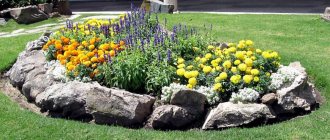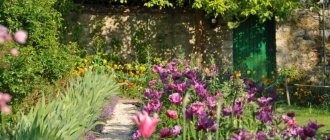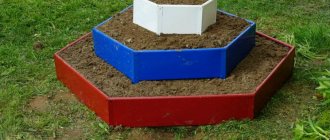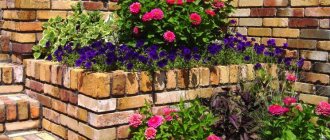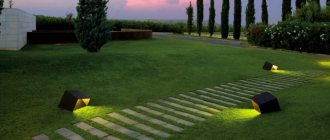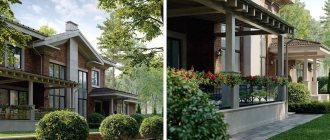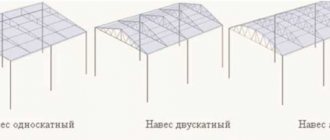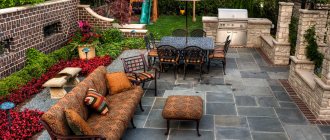Review author: Terrari School of Design
Decorative flower beds are gaining momentum in the landscape design of garden plots. The use of perennial plants makes it possible to enjoy flowering for a long time and reduce the effort for care, which is typical for seasonal plantings.
There is no need to rack your brain every year about what to plant and how to properly care for it. The best option for busy people is to choose perennial varieties to decorate the garden. Photo of a flower bed of perennials:
Perennials are an excellent basis for flower beds
Gardeners are very fond of perennial plants. They are great for organizing flower beds. The following advantages of perennials compared to annual plants can be identified:
- Lifespan of a plant. During the winter, only the top of the plant dies off, but the roots can live up to six or even more years.
- Easy to breed. To organize flower beds, you can use shoots, seeds and roots of plants.
- Medicinal properties. Many perennials have a healing effect.
Proper Neighborhood Observance
When combining different plants at close range, it is necessary to take into account the characteristics of the specimens, which can have both positive and negative aspects. The following types of “hostility” are known:
- roses with carnations, mignonette;
- lilies with tulips;
- lilies of the valley with peonies and violets.
Despite the negative interaction, some flowers are able to “help” their neighbors. Marigolds, nasturtium, petunia, and phlox have these features.
Rules for organizing flower beds
With the right choice of perennial plants, you get a flowerbed of continuous flowering: some species will begin to bloom, while others will immediately bloom.
Before planning the location of the flower garden, it is worth deciding where the paths and beds will be placed.
When choosing plants for beautiful perennial flower beds, you need to consider:
Periwinkle for decorating the garden area
Periwinkle is a perennial flower that covers the soil. During the flowering period, numerous blue flowers are formed around the entire perimeter of the plant. One bush can cover up to 3 m. Dense and dense foliage forms a green carpet.
It is used to decorate large areas under trees and to fill voids between bushes. Perennials are unpretentious in the growing process. They tolerate shady areas well and thrive in sunny areas.
Lack of watering and mineral fertilizing provokes slow growth and lack of flower stalks in early spring.
Soil type
The location on fertile black soil is loved by mallow, bluebell and lupine. If the soil has a lot of sand, clay or sandstone, then it is better to plant valerian, flax and sage.
Yarrow, cornflower and asters grow wonderfully on marshy soils, and carnations, cosmos, phlox and gaillardia grow on excessively dry soils.
Color compatibility
The correct selection of shades will help create an aesthetic flower bed. It should be remembered that:
- Matte plant leaves absorb light, while glossy leaves reflect it.
- It is better to choose plant species that bloom only in warm colors or only in cool colors.
- The lack of contrasts and a small number of species will help to visually enlarge the flower bed.
- Placing blue flowers at the back of the flower bed visually enlarges it. Planting flowers with yellow and red shades in the first row works in the same way.
- If the front part of the flower bed is bright, then its back half should be made calmer.
- For the background you should use soft tones, and bright contrasting colors should be added in small groups in a small area.
- There should be only one bright flower bed in the entire garden. The abundance of such flower beds will look too annoying.
Viburnum buldanezh for bright accents
This type of plant is a tall shrub, the length of which exceeds 3 m. In early May, the entire area of the bush is covered with numerous white inflorescences.
Viburnum buldenezh is used as individual plantings or to create regular flower beds. The plant is quite unpretentious for growing on sandy and clay soils.
The application of mineral fertilizers allows you to normalize the nutrient substrate and promote abundant flowering. It is necessary to plant bushes in sunny areas and protected from through air movement.
Types of compositions
Flowerbeds of different types are made from perennial plants. They are performed in one of two options:
- Regular composition. A geometric pattern is visible, and all the flowers bloom at the same time.
- Irregular composition. Such flower beds are more popular because the plants in them do not bloom at the same time. This allows you to enjoy flowering for a long time.
Garden hydrangea for landscape design
This type of plant is considered a favorite among gardeners.
Decorative inflorescences of unusual color attract the admiring glances of surrounding people. It is a shrub whose height reaches 2 m. The diameter of the crown can exceed 3 m. During flowering, long flower stalks with lush caps of bright flowers are formed. The palette of shades varies from soft pink to bright blue. To maintain the brightness of the flowers, it is necessary to regularly water with alkaline fertilizers.
If I like the prosperity of hydrangea, it is its capriciousness to the composition of the soil and the environment.
For regular flowering, timely pruning and feeding with nutrients are necessary. She can't stand the open sun. Sun rays can cause burns along the entire perimeter of the leaves.
Geometric flower beds
There are a large number of standard perennial flower bed designs. Regardless of the shape of the flowerbed, bright and tall plants should be planted in the center, medium-sized flowers in the middle, and low-growing ones at the edges.
Flowerbeds are usually designed in the shape of one of the following geometric shapes:
- Rectangle. Such flower beds are distinguished by their clarity of shape. By combining flowers, you can make different designs.
- Oval. Combining different types of plants allows you to create fascinating designs in your flowerbed.
- Circle. A round flowerbed in a country house is very popular because this shape makes it easier to care for plants.
- Triangle. Such flower beds are quite rare, but they can be placed where there is not a lot of free space.
Recently, another common option for flower beds is planting plants in boxes up to one meter high. They are more difficult to create, but there will be no problems with weeds and flower care.
Planning
A carefully planned flowerbed will leave the most pleasant impressions. Together you can combine flowers of different types, as well as shrubs, conifers, and various decor.
Follow the following sequence:
- Assess the similarity of care requirements. Moisture-loving and drought-resistant, light-loving and shade-tolerant specimens cannot be planted in close proximity.
- The presence of aggressor plants that have a detrimental effect on the life of other species is excluded.
- Perform a schematic arrangement. The type depends on the nature of the flower bed and the selected plants.
Only after these steps do they begin to form the appearance of the composition. They work with a color scheme and the arrangement of components along the contour.
Seeing a landscaped area from the window without making any serious effort is the dream of any summer resident. Landscape design consists of many actions, the most important of which will be the design of flower beds.
Types of flower beds by planting density
According to the density of planting, the following flower beds are distinguished:
- Solitaires. Single plants or shrubs with large flowers or leaves are planted at a fairly large distance.
- Discounts. They are strips running along paths, walls or fences.
- Curbs. They look like the edging of a flower bed.
- Parterres. A spacious flower garden combining a lawn, border and ridge.
- Mixborders. Popular with non-professionals. Such flower beds bloom from the beginning of spring until the onset of frost.
- Arrays. They are large flower beds with plants that do not require special care.
- Groups. They are distinguished by their smooth shapes and bright floral spots located on the lawn or area.
- Arabesque. Pebbles and colored stones are used in their design.
- Vases. In this case, the plants are planted in vases or nets similar to baskets.
- Rock garden or rock garden. Similar flower beds of flowering perennials imitate mountainous terrain.
White dogwood for garden decoration
This type of plant is a tall shrub that tolerates pruning and various manipulations with the crown. The leaf plates are made in 2 shades. The middle is bright green, and the edge is decorated with a white border.
The height of an adult plant reaches 3 m. The volume of the crown is up to 5 m. During the flowering period, there are more than 100 pink flowers throughout the entire crown area.
Plants suitable for perennial beds
Below are perennial flowers for the flower bed that look perfect in the garden:
- Geranium Endressa. It blooms all summer, tolerates drought well and is very unpretentious.
- Aconite. Blooms from early July to late August.
- Delphinium. It blooms in the first two months of summer, but if it is cut off immediately after the end of flowering, the flower stalks may reappear before the onset of cold weather.
- Avens. Blooms already in May. In good weather it may bloom a second time in early autumn.
- Dicentra. Quite a popular plant that blooms in April and May.
- Bell. A perennial flower that prefers to grow in the shade. Blooms from early June.
- Doronicum plantain. An excellent plant for planting in a moist, shady area.
- Meconopsis. An unpretentious plant that requires only the removal of faded buds. Blooms in May and June.
- Sage. Very common because after pruning it blooms a second time. It pleases with its flowering all summer long.
- Hellebore. Ideal for planting in a shaded area with fertile soil.
- Funkia. It has decorative green leaves, so it is used to add greenery to a flower bed.
- Musk mallow. A fairly unpretentious plant that grows well both in the sun and in the shade. Pleases with flowering from June to September.
- Sedum. Belongs to the succulent family. Blooms from mid-summer to early autumn.
If you take into account the time of appearance of flowers in different plants, you can create a continuously blooming flower bed.
Let's sum it up
In conclusion, it is worth noting that when choosing perennials for your flowerbed, it is recommended to select those flowers that have approximately the same flowering time. After all, you must agree that a flower garden with budding buds and dried flowers nearby will look rather untidy, and the whole composition will be ruined.
In addition, novice gardeners must take into account that perennials must bloom all spring, summer and autumn, only in this way the flower bed can delight you with its attractive appearance all year round. There are now many different types of plants that continue to bloom throughout the season. These flowers include the following: roses, violets, pansies. It is also recommended to use evergreen shrubs and ornamental grasses in the design of flower beds.
Rosarium
You can create a beautiful flower bed by planting only roses on it. In this case, it will be called a rosarium.
Caring for such a flowerbed will require more effort, but the resulting result will please the eye for a long period of time.
If different varieties of roses were used to decorate a flower bed, it is called a mixed rose garden.
Flowerbeds that do not require maintenance
For gardeners who don't have a lot of time and energy, lazy flower beds are the ideal solution. This option involves planting plants that require almost no care, fertilizing or other special conditions. They can delight with their flowering from the very beginning of spring until the end of autumn.
Peonies, sedum, geranium, astilbe, hosta and bergenia are perfect for a lazy flower bed. Adding aster and phlox will decorate the flower bed with bright flowers.
Stores often offer sprouts and a ready-made scheme for planting them. Such a flowerbed will delight its owners with flowering from early spring to late autumn.
In addition to the plants listed above, the following are ideal for organizing a lazy flower bed: clematis, daylily, cornflower, daffodils, lupine and irises.
The main thing is not to choose too many species, otherwise caring for the flowerbed will become much more difficult and painstaking.
Photos of flower beds of perennials amaze with their beauty and diversity. They must certainly be present on the plot.
Bright astilbe for garden decoration
To date, more than 350 varieties of this plant are known. A distinctive feature of this perennial is its bright and colorful flowering in early summer and until late autumn. Peduncles reach up to 15 cm in length. The flowers are made in the form of colorful panicles.
Plants love shaded areas and regular watering. This allows you to improve its decorative qualities and stimulate active growth.
Photos of perennial flower beds
Please repost


